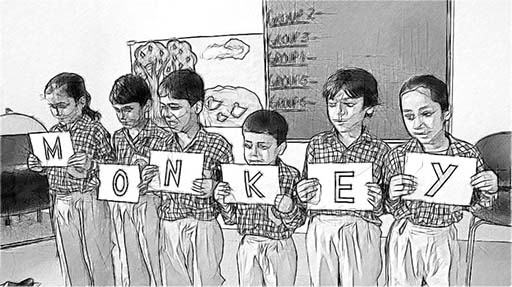3 Words and spellings
Hearing and using rhyming words helps students to recognise letter and sound patterns in English. Textbooks contain lessons that ask students to look for selected short words within a longer text. You can adapt these lessons to help students identify rhyming words.
Activity 3 uses an extract from a Class I textbook. The words at the beginning of the extract are rhyming words. One word in each pair occurs in the story, and students must look for these words.
Activity 3: Using the textbook for word work
This activity helps students to use words in a meaningful context. Try it yourself.
Read and say these words aloud. Then circle the words you find in the story.
| few | bed | see | back |
| new | red | tree | sack |
Ravi is crying. ‘I CAN’T SEE MY NEW BAG!’ he says.
‘Is your bag new?’ asks the teacher.
‘Yes, it is,’ says Ravi.
‘Is it red and yellow?’
‘Yes, it is.’
‘I can see it,’ says the teacher.
‘Where?’
‘It’s on your back!’
Now choose a short extract from your textbook and create an activity like the one above, making a set of rhyming words to go with extract.
Use the extract and rhyming words you prepared from the textbook with your students. Demonstrate to the students how to work through the activity, doing the first word yourself.
If the extract you choose is a dialogue, read the dialogue aloud, helping to ensure that the students understand it. You could act out the two different parts using different voices or ask a student to act it out with you. Use mime and gesture, and any classroom objects, to ensure that students understand the meaning.
As students work through this activity, you can evaluate their skills in recognising and reading English letter patterns. Encourage them to read out the extract and hear the rhyming words spoken aloud.
In the next activity, you look at the relationship between letters, sounds and spellings in English.
Activity 4: Using letters and sounds to spell
This is an activity for you.
Read the beginning of a story in English, written by an eight-year-old girl:
Ther ouns was two flawrs. Oun was pink and the othr was prpul. Thae did
not like ech athr becuse thae whr difrint culrs. Oun day thae had a fite.
Could you read this story and understand it? How would you assess it?
The student is using all she knows about the letters and sounds of English to write her story. She is using her best judgements about how to spell. These invented spellings are a stage in reading and writing development. It is important to see students’ invented spellings as part of the developmental process of literacy – they are not errors or mistakes.
When your young students begin to write in English, they are likely to go through these stages of spelling development:
- Using a single letter to represent a word or sound; for example, ‘u’ for ‘you’, or ‘m’ for ‘am’.
- Using a letter or group of letters to represent a word; for example, ‘kam’ for ‘come’, ‘lv’ for ‘love’ and ‘dis iz a kat’ for ‘this is a cat’.
Now look at some of your students’ English writing and see if you can find invented spellings in English.
What has been your response to these invented spellings? Do you correct them right away? How do students respond to your corrections? Do you ever ask students to explain their English spellings to you, in their home language?
It is important that you do not over-correct invented spellings, because students are experimenting with the letters and sounds of the language they are learning. Students acquire ideas about spelling as they hear language, read and write. Over time, with exposure and practice, their spelling will become increasingly correct.

2 Letters, sounds and words in the classroom
